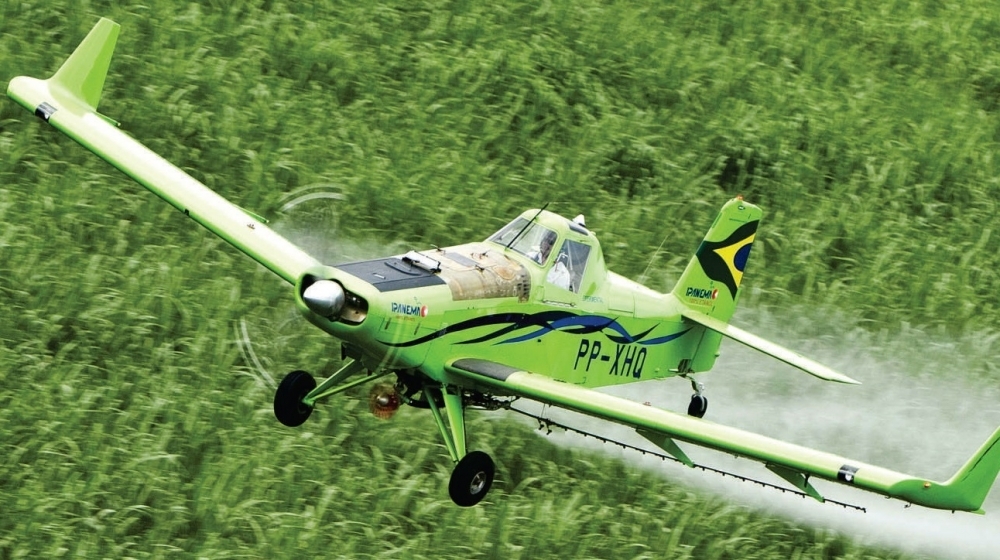

Technology replaces conventional manual procedure with on-board hardware and electromechanical system containing a sensor and actuator that can spray crops without a pilot's involvement, saving fuel and consuming less pesticide (photo: release)
Researchers have developed technology with funding from FAPESP's Innovative Research in Small Business program.
Researchers have developed technology with funding from FAPESP's Innovative Research in Small Business program.

Technology replaces conventional manual procedure with on-board hardware and electromechanical system containing a sensor and actuator that can spray crops without a pilot's involvement, saving fuel and consuming less pesticide (photo: release)
By Diego Freire | Agência FAPESP – Crop dusting aircraft are frequently used for the aerial application of agrochemicals, but many agricultural enterprises spray pesticides manually, wasting material and potentially jeopardizing accuracy and safety. Researchers at a company in São José dos Campos, São Paulo State, Brazil, set out to minimize these problems. With FAPESP’s support, they developed a customized product line for the automation of aerial pesticide application.
The technology was developed as part of the project “On-board automatic control system (SECA): development of a new algorithm and equipment for automation of pesticide application in agricultural aircraft”, conducted by NCB Sistemas Embarcados Ltda. with funding from FAPESP’s Innovative Research in Small Business (PIPE) program.
The conventional procedure consists of aerial spraying of a crop in a parallel strip or grid formation and in a direction perpendicular to the wind, with some overlapping passes being repeated over certain segments in order to guarantee total coverage of the area concerned.
The technology developed by NCB, a tech startup founded in 2006, replaces the manual control and drive mechanism with on-board hardware and an electromechanical system containing a sensor and actuator integrated in real time with the other components of the platform to spray crops autonomously without participation by the pilot. The system reduces agrochemical consumption by at least 10% and permits fuel savings of up to 5%.
“Brazil’s agribusiness sector needs more technology in order to develop in accordance with actual conditions and local needs. Automation is a key part of this process. It facilitates the lives of growers and reduces their costs, especially given the high cost of pesticide. NCB focuses on the development of products that promote the sustainable use of crop spraying inputs and resources, including equipment and software for agricultural aircraft to facilitate the sustainable application of crop protection products,” said Fernando Garcia Nicodemos, NCB’s managing partner for research and development.
FLuX I
The first component developed by NCB was FLuX I, a flow meter used to monitor the spray application rate in real time.
The pilot activates the system to calculate the ideal spray rate and the total amount of pesticide to be applied. Simplified calibration is available to ensure that the monitored rate genuinely represents the amount of spray applied, avoiding waste.
The platform consists of a digital monitor installed on the aircraft dashboard and a turbine sensor coupled to a filter affixed to piping under the plane’s belly. According to Nicodemos, “the technology is easy to install and compatible with all aircraft used in Brazil”.
The control software includes a new algorithm created by the researchers involved in the project to automate aerial application. The algorithm was tested and validated in models running in a simulated environment.
NCB is now working with ANAC, Brazil’s civil aviation authority, to certify the product line while preparing to produce batches for sales campaigns, including demonstration and training units for representatives. This stage is supported by FAPESP under the project “Technical and commercial development of products for navigation and pesticide application automation in agricultural aircraft” with funding from the FINEP-PAPPE-PIPE III program.
“We’re hoping to succeed in winning a share of the agricultural aviation market with this innovative product line,” Nicodemos said. “Our crop spraying automation offering assures balance and sustainability in economic, social, environmental and safety terms.”
According to the Brazilian Aeronautical Register maintained by ANAC, all aircraft registered in Brazil in 2010 had basic navigation equipment. However, 90% had obtained this equipment from only two foreign suppliers.
For Nicodemos, the solution is local development of precision agricultural equipment involving on-board electronic guidance and navigation systems for ground and air vehicles, such as crop sprayers, tractors, harvesters and agricultural aircraft.
“Manual control of crop protection product application still predominates in the Brazilian market, using mainly mechanical components,” Nicodemos said. “The outlet valve is manually opened by the pilot, who starts and stops the process in each application. It’s a rough-and-ready procedure, and it’s not very safe.”
Republish
The Agency FAPESP licenses news via Creative Commons (CC-BY-NC-ND) so that they can be republished free of charge and in a simple way by other digital or printed vehicles. Agência FAPESP must be credited as the source of the content being republished and the name of the reporter (if any) must be attributed. Using the HMTL button below allows compliance with these rules, detailed in Digital Republishing Policy FAPESP.





